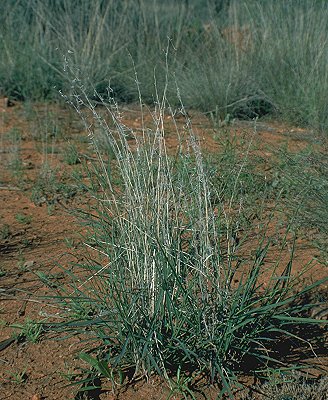 |
 |
|
 |
 |
|

Monachather paradoxus Steud.
|
Common name
Bandicoot Grass
Mulga Oats
Derivation
Monachather Steud., Syn. Pl. Glumac. 247 (1854); from the Greek
monarchos (solitary) and ather (spike as in an ear of wheat),
referring to the solitary wheat-like spike.
paradoxus- from the Greek para (irregular) and doxa (opinion). Different from the expected in regard to related species.
Published in
Syn. Pl. Glumac. 1: 247 (1854).
Common synonyms
Danthonia bipartita F.Muell.
Habit
Perennial, tufted. Basal leaf sheaths thickened and forming a bulb, woolly.
Culms erect, 25–70 cm tall. Leaves mostly basal. Ligule a fringed membrane,
1–3 mm long. Leaf-blades 7–16 cm long, 2–5 mm wide. Leaf-blade
surface pilose, with tubercle-based hairs.
Inflorescence
Inflorescence compound, a panicle, comprising 8–25 fertile spikelets. Panicle
open or contracted, linear, effuse, 5–20 cm long, 2 cm wide.
Spikelets
Spikelets solitary. Fertile spikelets many flowered, comprising 5–6 fertile
florets, with diminished florets at the apex, cuneate, laterally compressed,
8–17 mm long, breaking up at maturity. Spikelets disarticulating below
each fertile floret. Floret callus bearded, hairs 25% of length of lemma.
Glumes
Glumes persistent, similar, thinner than fertile lemma, gaping. Lower glume
ovate, 8–17 mm long, equalling upper glume, chartaceous, 11–13-nerved.
Lower glume apex acute. Upper glume ovate, 8–17 mm long, 110% of length
of adjacent fertile lemma, chartaceous, 11–13-nerved. Upper glume apex
acute.
Florets
Fertile lemma oblong, 2–15 mm long, coriaceous, 9-nerved. Lemma surface
pilose or villous, with a transverse fringe of hair. Lemma apex lobed, 2-fid,
with linear lobes, with lobes 3–8.4 mm long, attenuate, incised 66%
of lemma length,1-awned. Median (principal) awn from a sinus, 3.2–7.8 mm
long overall, not or scarcely exserted from spikelet. Palea elliptic or ovate,
2.7–3.5 mm long, 33% of length of lemma, coriaceous, 0-nerved, without
keels. Palea surface glabrous. Apical sterile florets resembling fertile though
underdeveloped. Lodicules 2, smooth. Anthers 3, 0.25–2.8 mm long. Grain
with adherent pericarp, 1.2–1.8 mm long. Hilum linear, 25% of length
of caryopsis.
Continental Distribution:
Australasia.
Australian Distribution:
Western Australia, Northern Territory, South Australia, Queensland, New South
Wales.
Western Australia: Giles, Helms, Fortescue, Ashburton, Carnarvon, Austin, Irwin, Drummond, Dale, Avon, Coolgardie. Northern Territory: Central Australia North, Central Australia South. South Australia: North-western, Lake Eyre, Nullabor, Gairdner-Torrens Basin, Eastern, Eyre Peninsula. Queensland: Darling Downs, Gregory South, Mitchell, Warrego, Maranoa. New South Wales: North-Western Plains, South-Western Plains, North Far Western Plains.
Classification. (GPWG
2001):
Danthonioideae
Notes
Native. Arid grasslands, often reported from sand, usually as a minor element with mulga,
naked woollybutt, and hard or feathertop spinifex. Flowers May to Sep.

Habit (photo)
© D. Albrecht